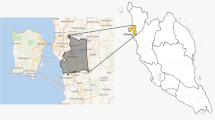Summary
The arsenic content has been analysed in millimeter sections of hairs shaved from Napoleon's scalp May 6th, 1821, the day after his death. It appeared that Napoleon was exposed to arsenic on at least 40 occasions between the summer of 1820 and April 1821. So were hairs cut in each of the years 1818, 1817 and 1816 analyzed in centimeter sections. The 1818 hairs disclosed that Napoleon was exposed to arsenic during some three months sometime between January, 1817, and March, 1818. The 1816 hairs showed particularly high concentrations of arsenic which must have been deposited before Napoleon was exiled to St. Helena.
Similar content being viewed by others
References
Antommarchi, F.: Les derniers momens de Napoléon. Paris 1825.
—: Rapport du Dr. Antommarchi. In: Mémoires de Marchand, tome II. Paris: Plon 1955
Boutron, D'Arcet, Pelletiers etOllivier: Exhumation des Restes de l'Empereur Napoléon. Ann. Hyg. publ. (Paris)25, 11 (1841).
Douris, R.: Toxicologie moderne. Paris: Vigot 1951.
Forshufvud, S.: Who killed Napoleon? London: Hutchinson 1962.
—: Mord an Napoleon? (Econ, Düsseldorf 1962).
—,H. Smith, andA. Wassén: Arsenic content of Napoleon I's hair probably taken immediately after his death. Nature (Lond.)192, 103 (1961).
Funck-Brentano, F.: Le drame des poisons. Paris: Hachette 1920.
Henry, N.: Appearances on the examination of the body of Napoleon Bonaparte 6th May 1821. Lowe's Papers. Brit. Museum.
Kratter, J.: Lehrbuch der gerichtlichen Medizin. Stuttgart: Ferdinand Enke 1912.
Marchand, L.: Mémoires de Marchand, tome II. Paris: Plon 1955.
Merkel, H.: Die Magenverätzungen. In: Handbuch der speziellen pathologischen Anatomie und Histologie vonHenke u.Lubarsch, Bd. IV/1. Berlin: Springer 1926.
Petri, E.: Pathologische Anatomie und Histologie der Vergiftungen. In: Handbuch der speziellen pathologischen Anatomie und Histologie vonHenke u.Lubarsch, Bd. X. Berlin: Springer 1930.
Shortt, Th., A.Arnott, Ch.Mitchell, F.Burton, and M.Livingstone: Report of appearances on dissection of the body of Napoleon Bonaparte. Lowe's Papers, Brit. Museum.
Smith, H.: Estimation of arsenic in biological tissue by activation analysis. Analyt. Chem.31, 1361 (1959).
—,S. Forshufvud, andA. Wassén: Distribution of arsenic in Napoleon's hair. Nature (Lond.)194, 725 (1962).
Stolman, A., andC. P. Stewart: Toxicology, mechanisms and analytical methods. London: Academic Press 1960.
Author information
Authors and Affiliations
Rights and permissions
About this article
Cite this article
Forshufvud, S., Smith, H. & Wassén, A. Napoleon's illness 1816–1821 in the light of activation analyses of hairs from various dates. Arch. Toxikol. 20, 210–219 (1964). https://doi.org/10.1007/BF00577893
Received:
Issue Date:
DOI: https://doi.org/10.1007/BF00577893




